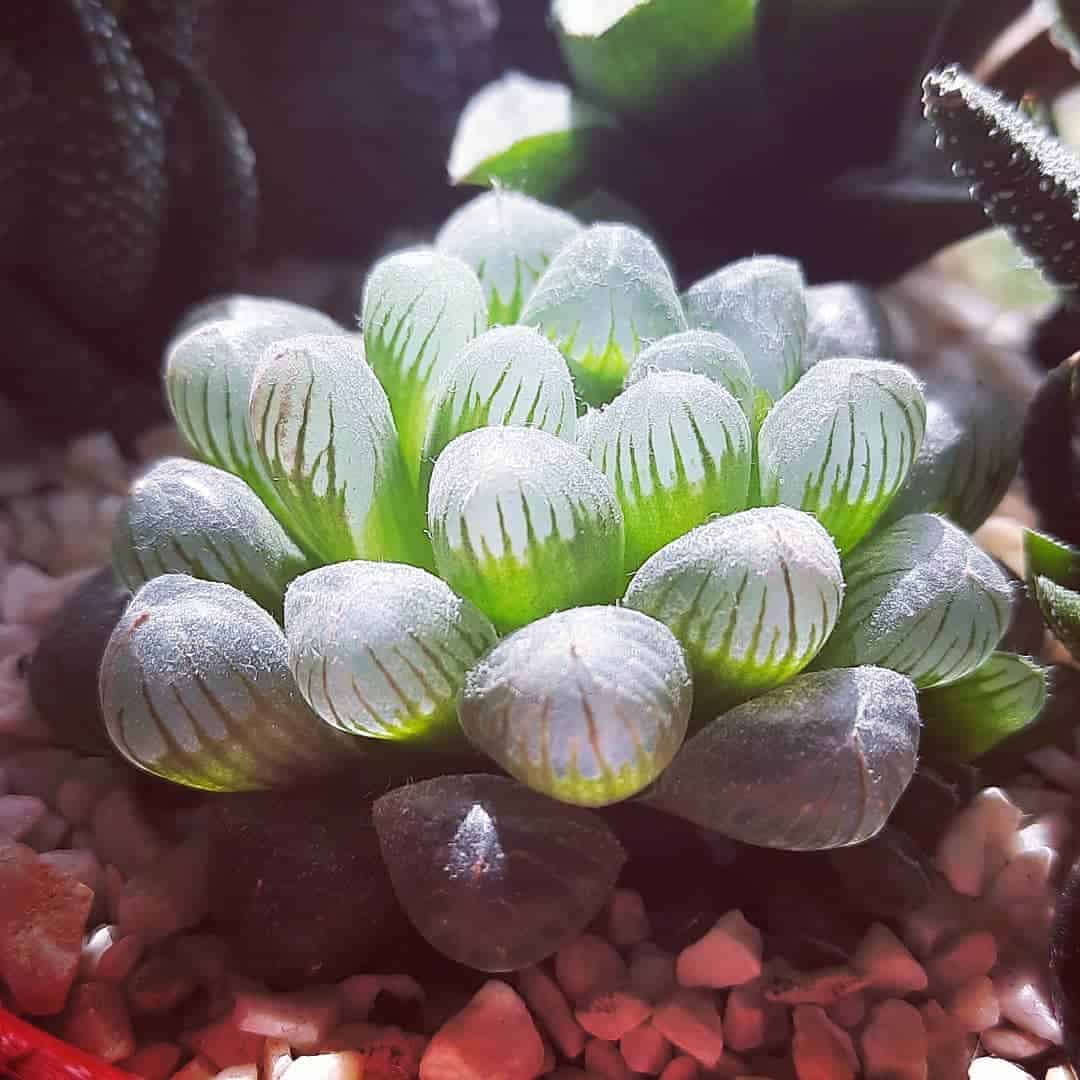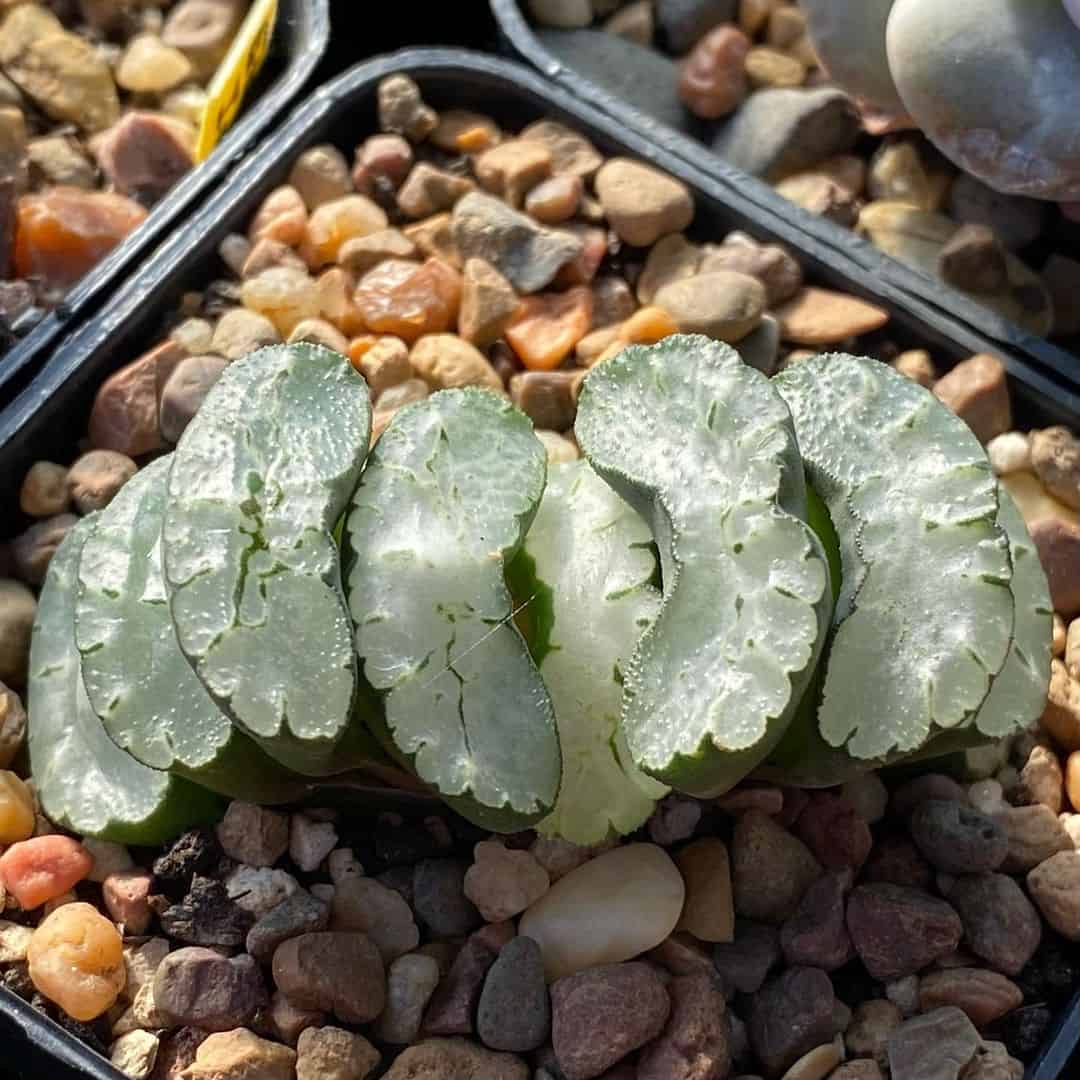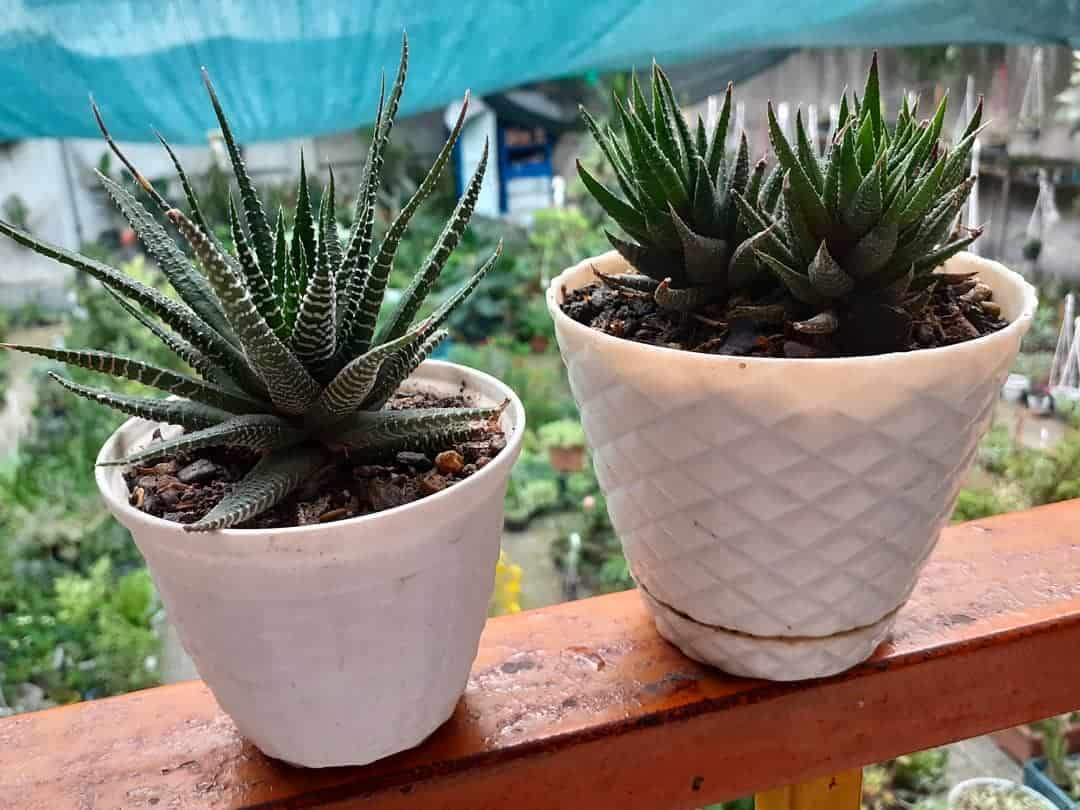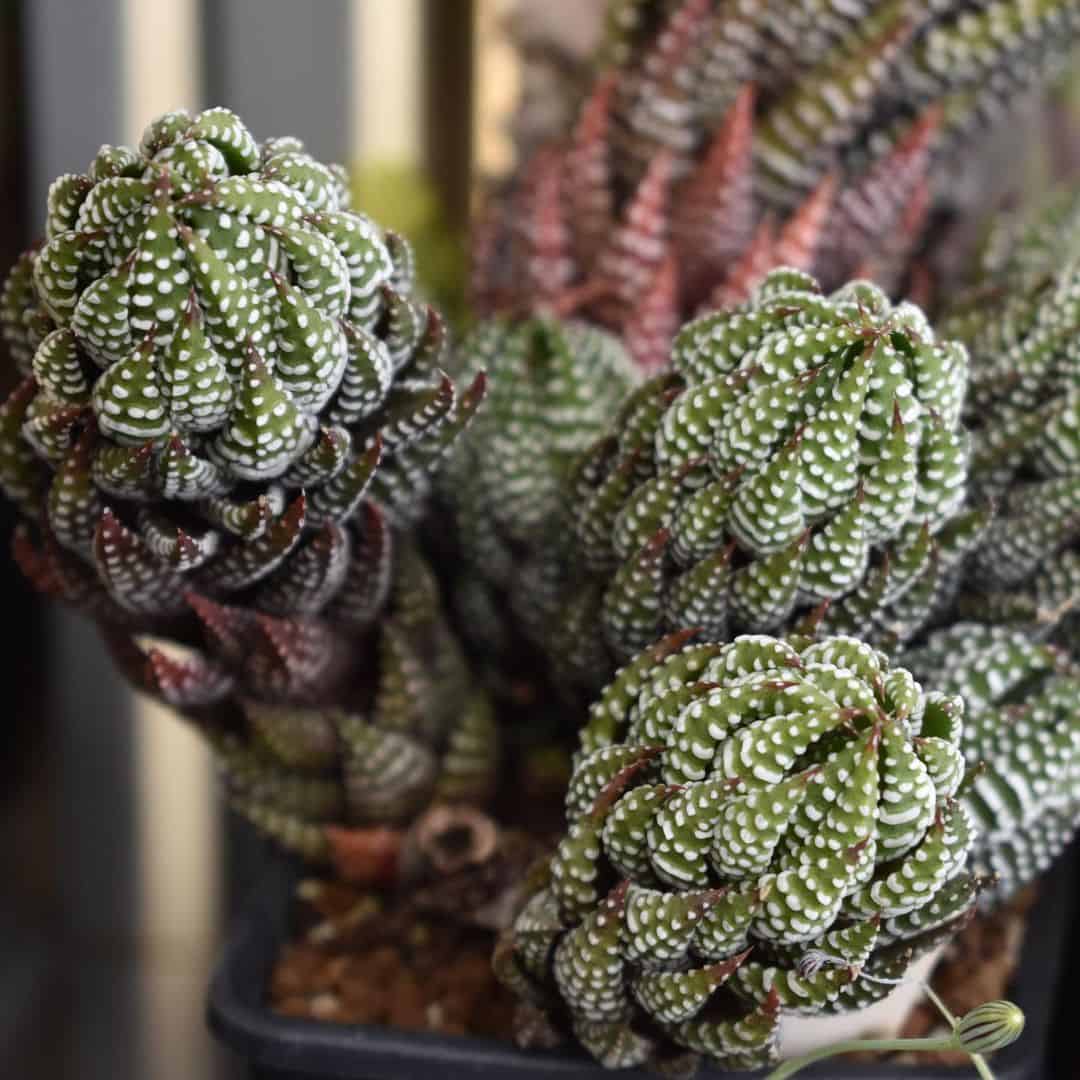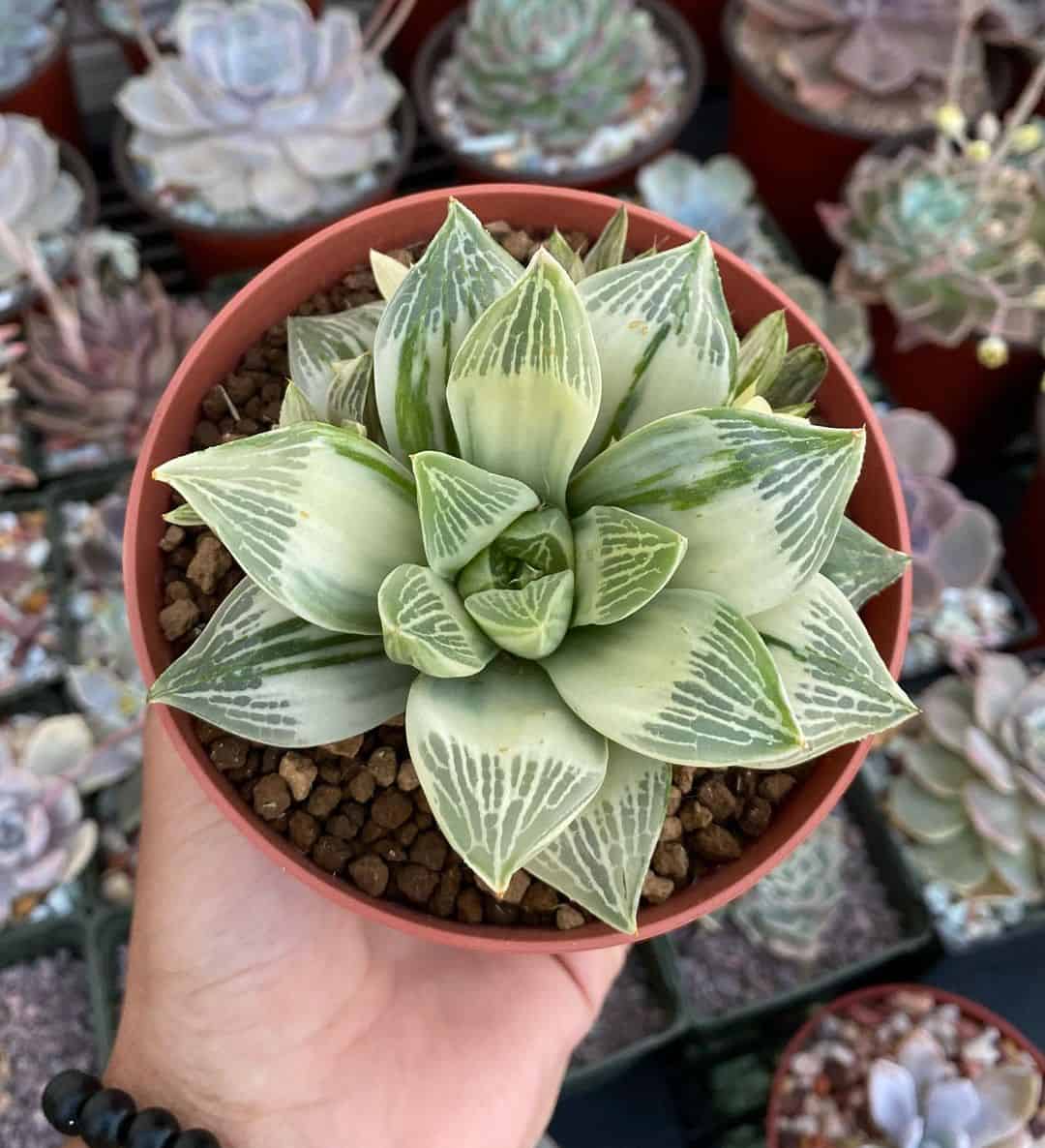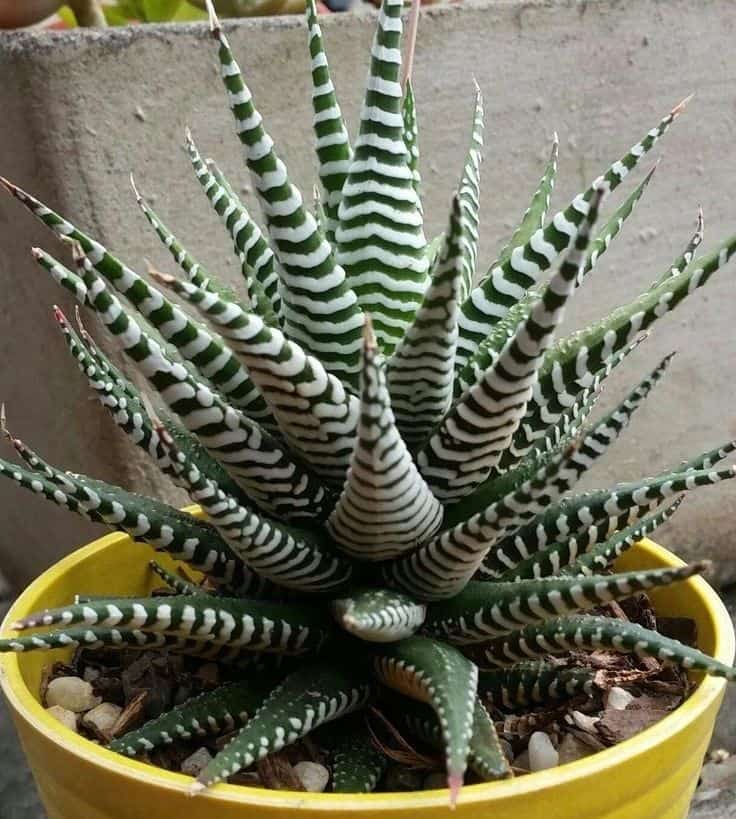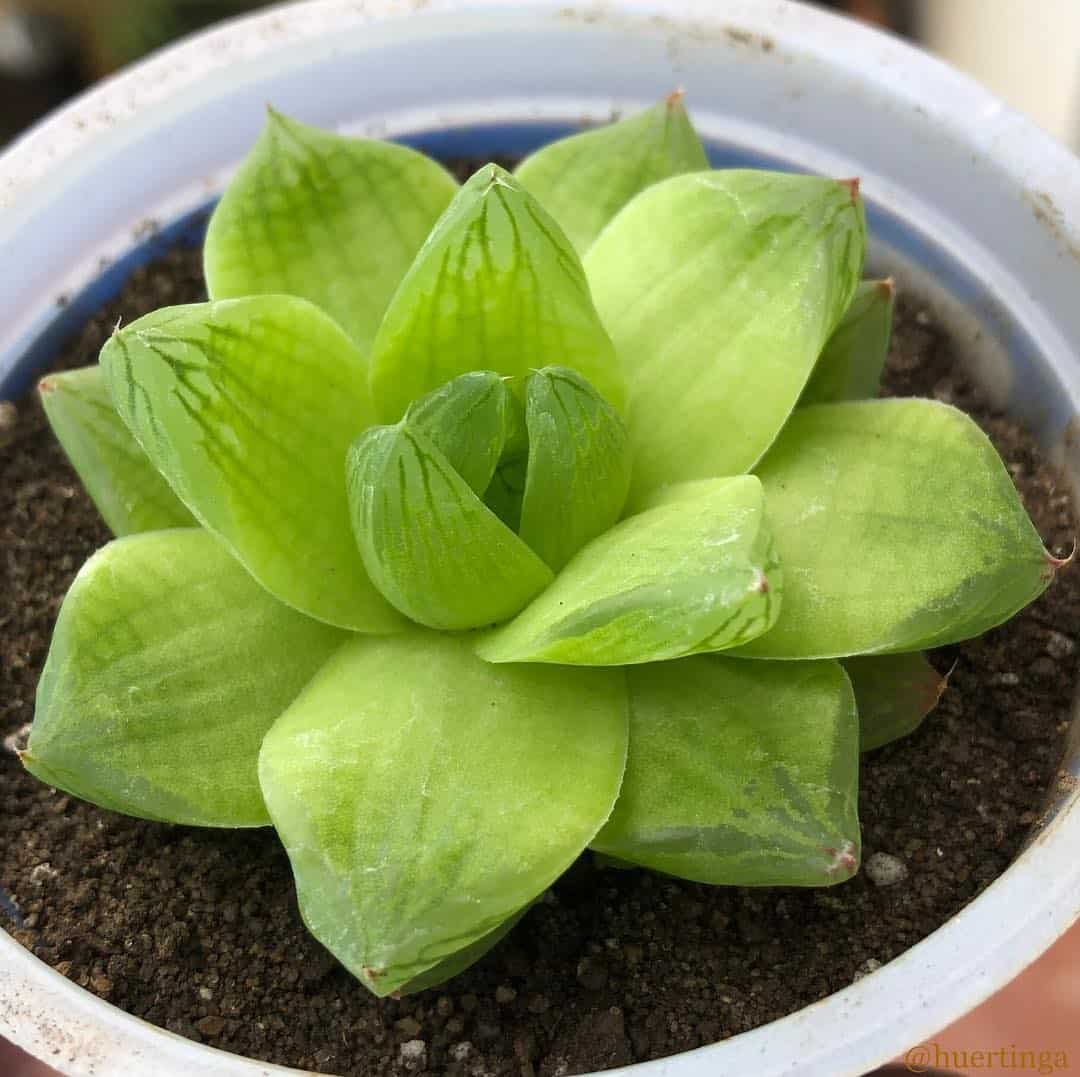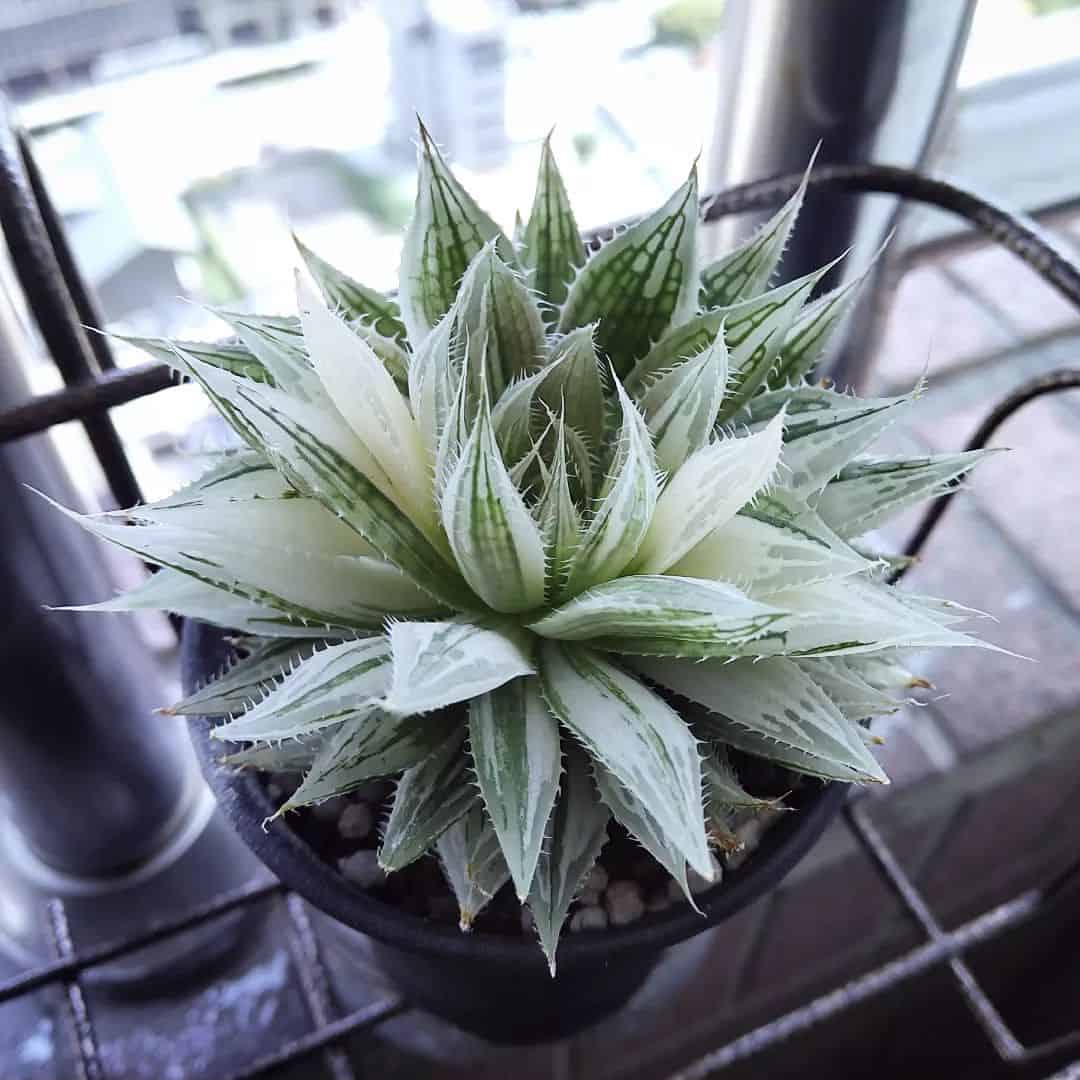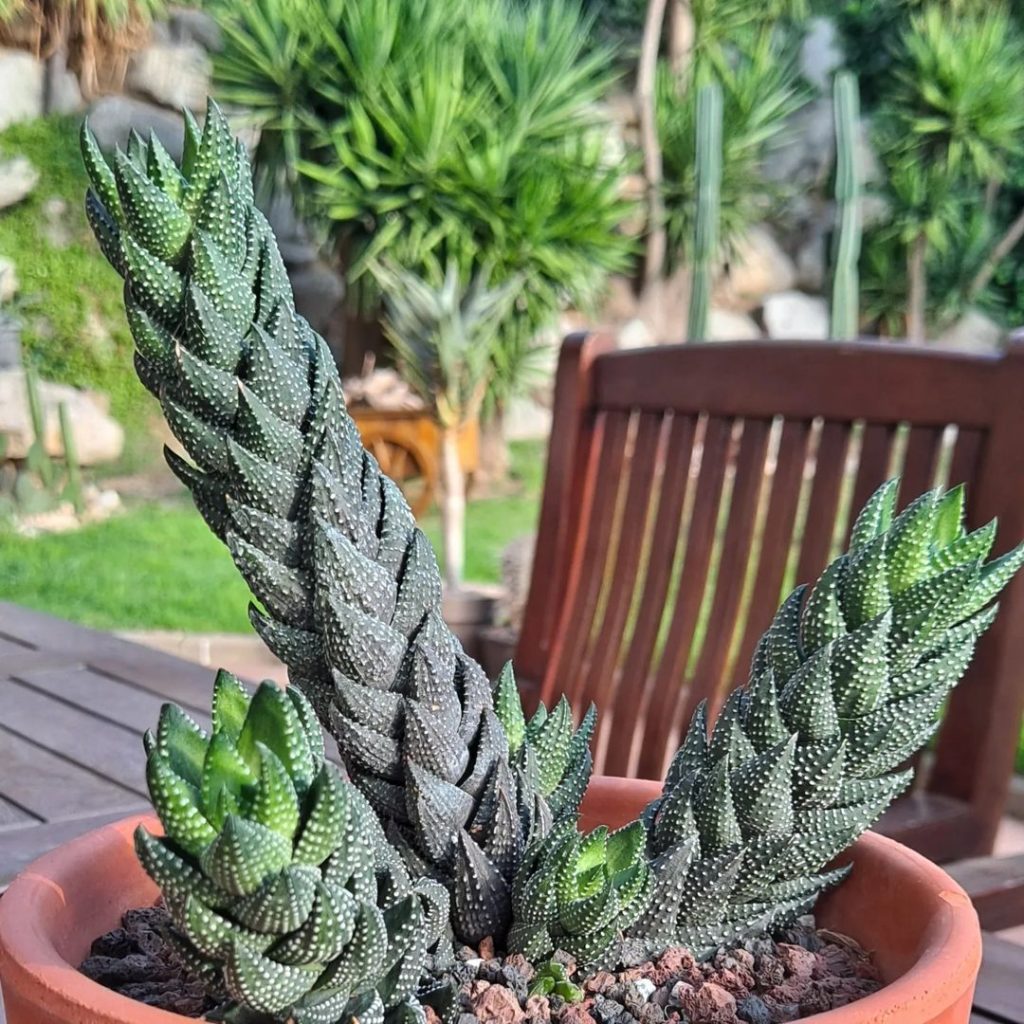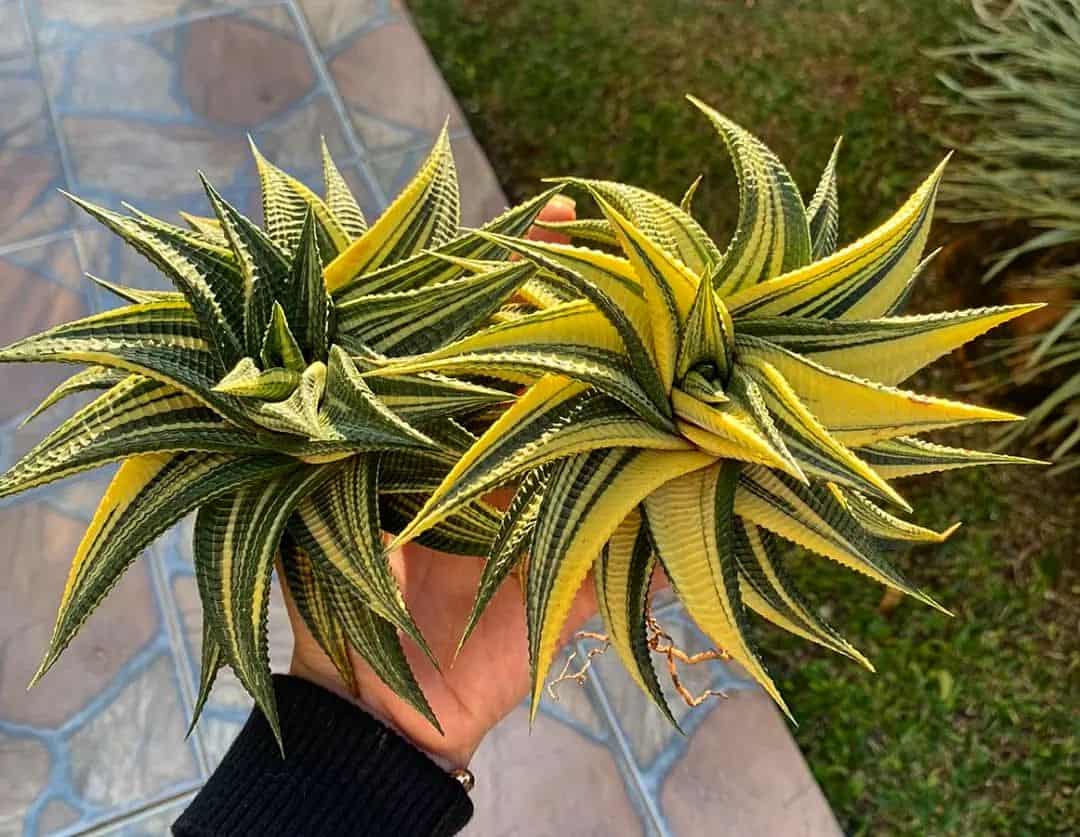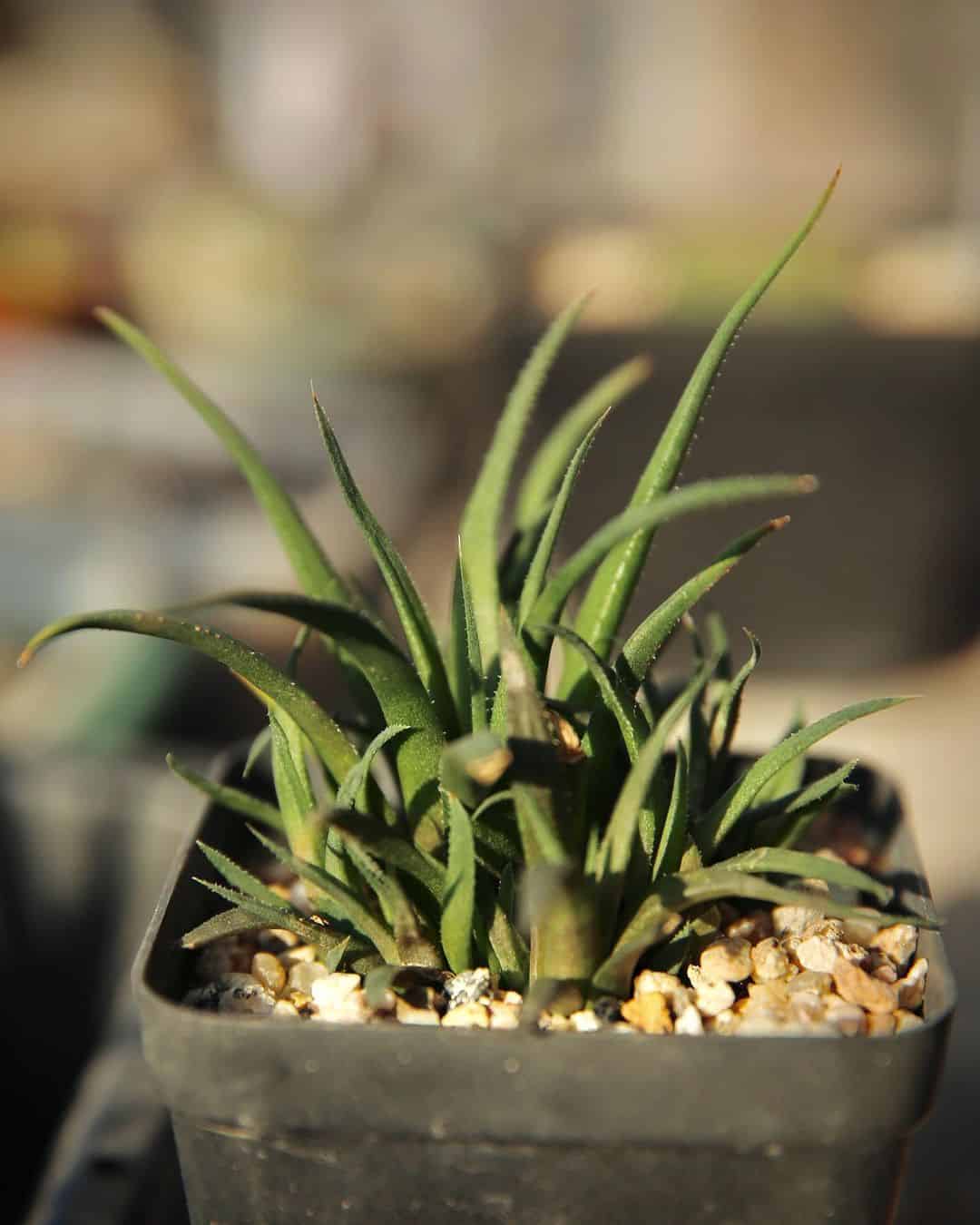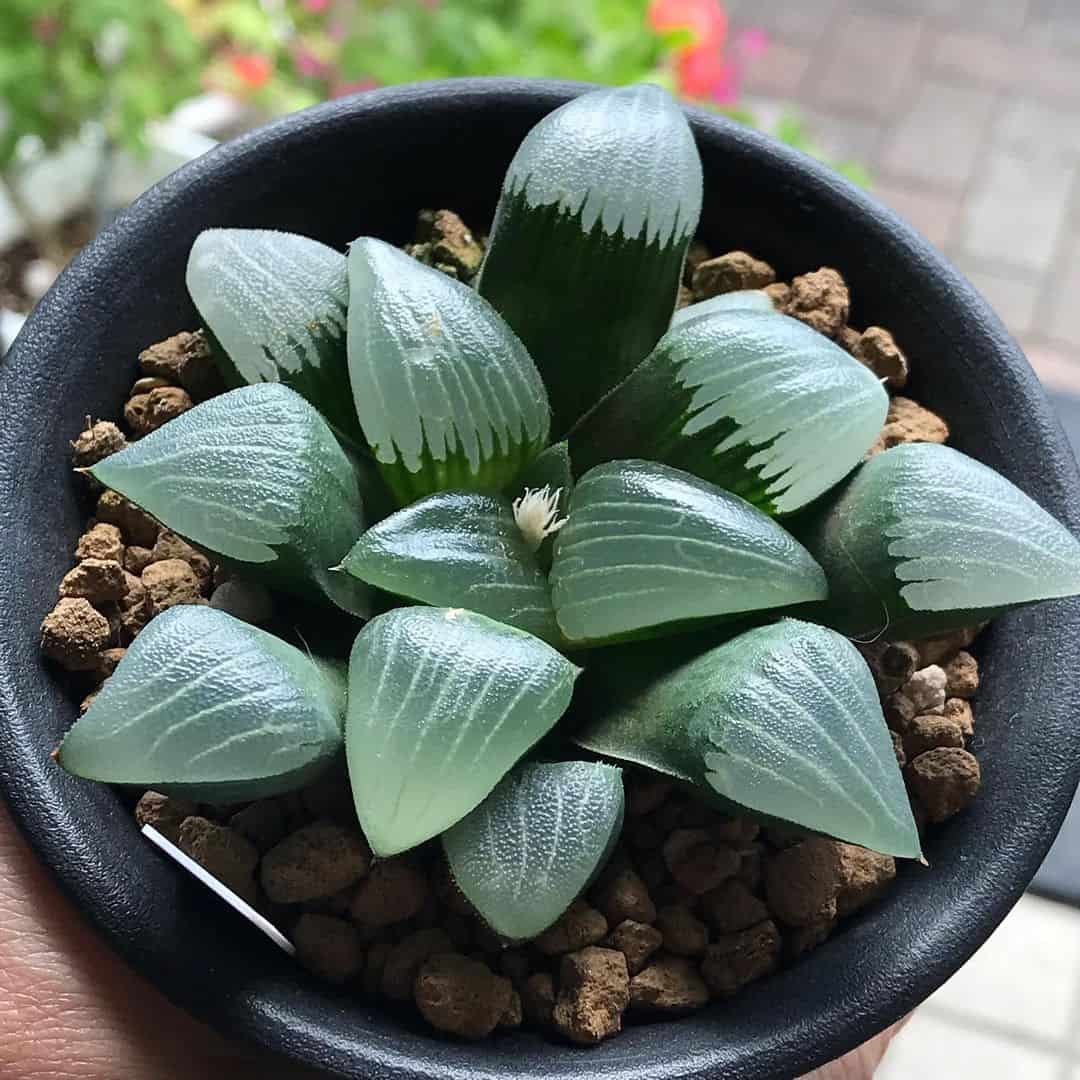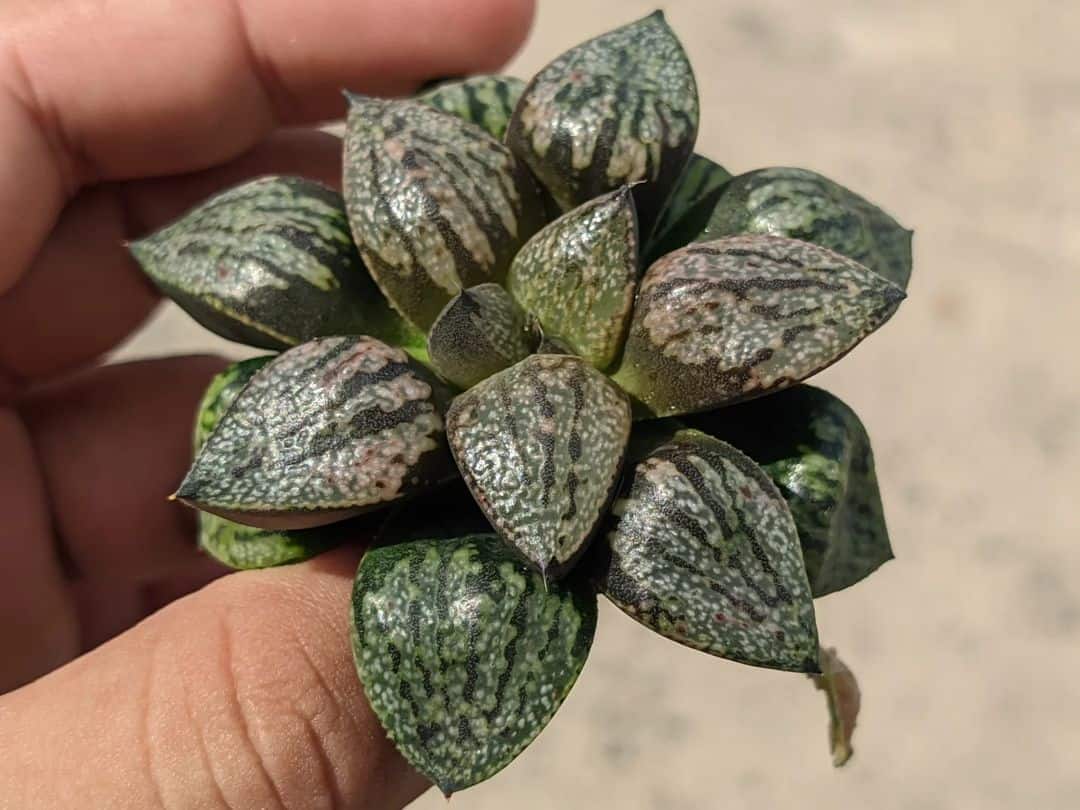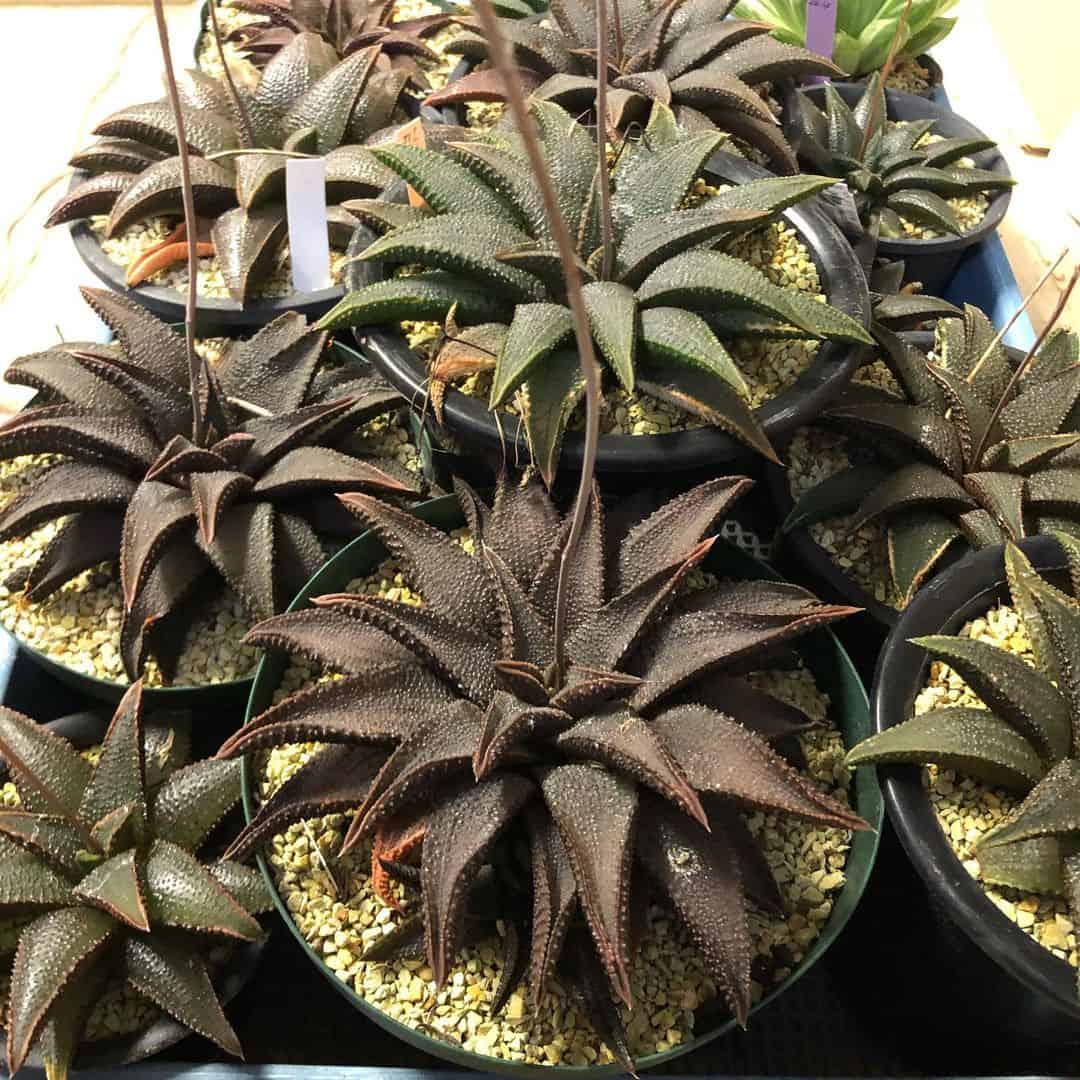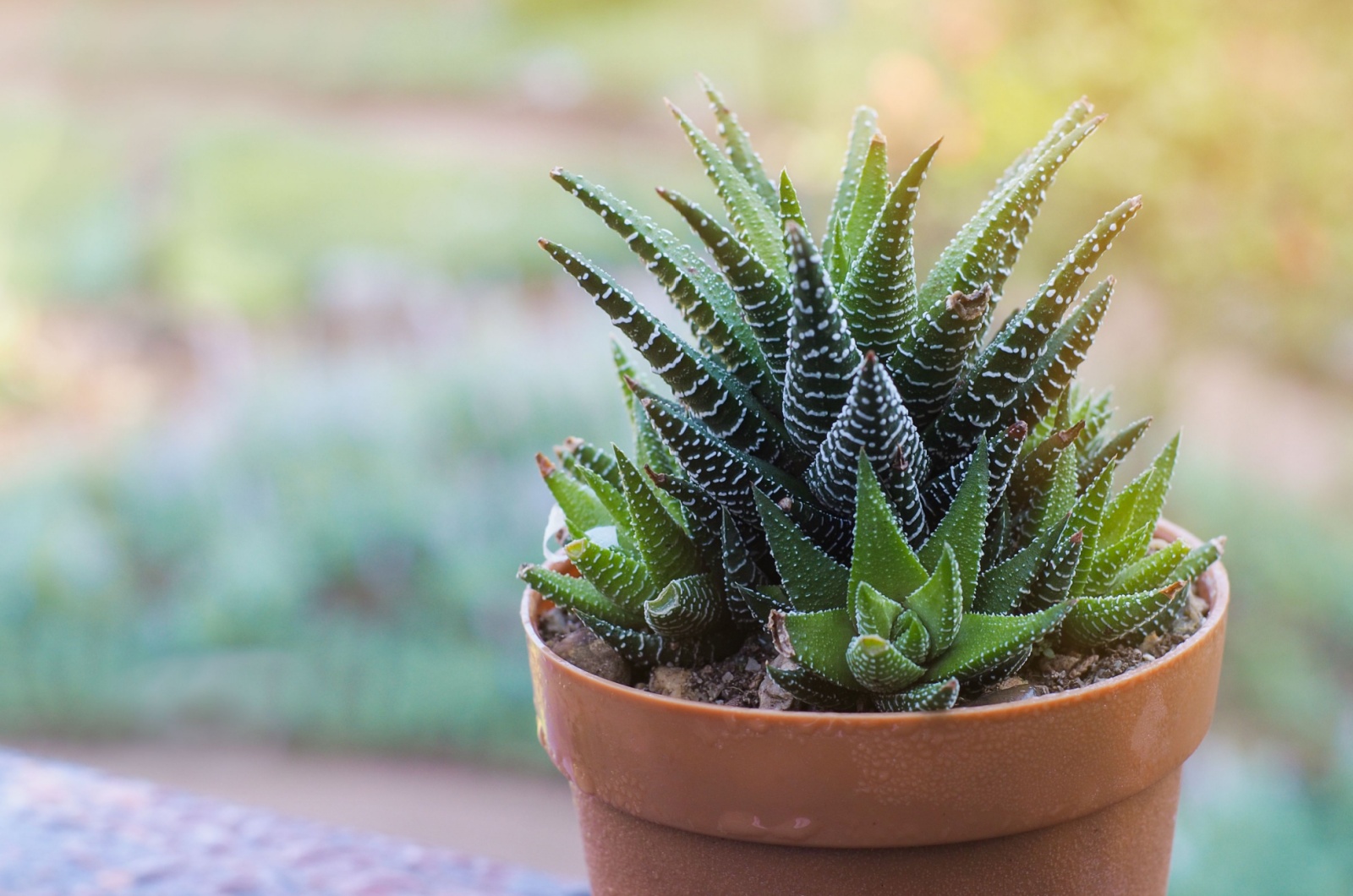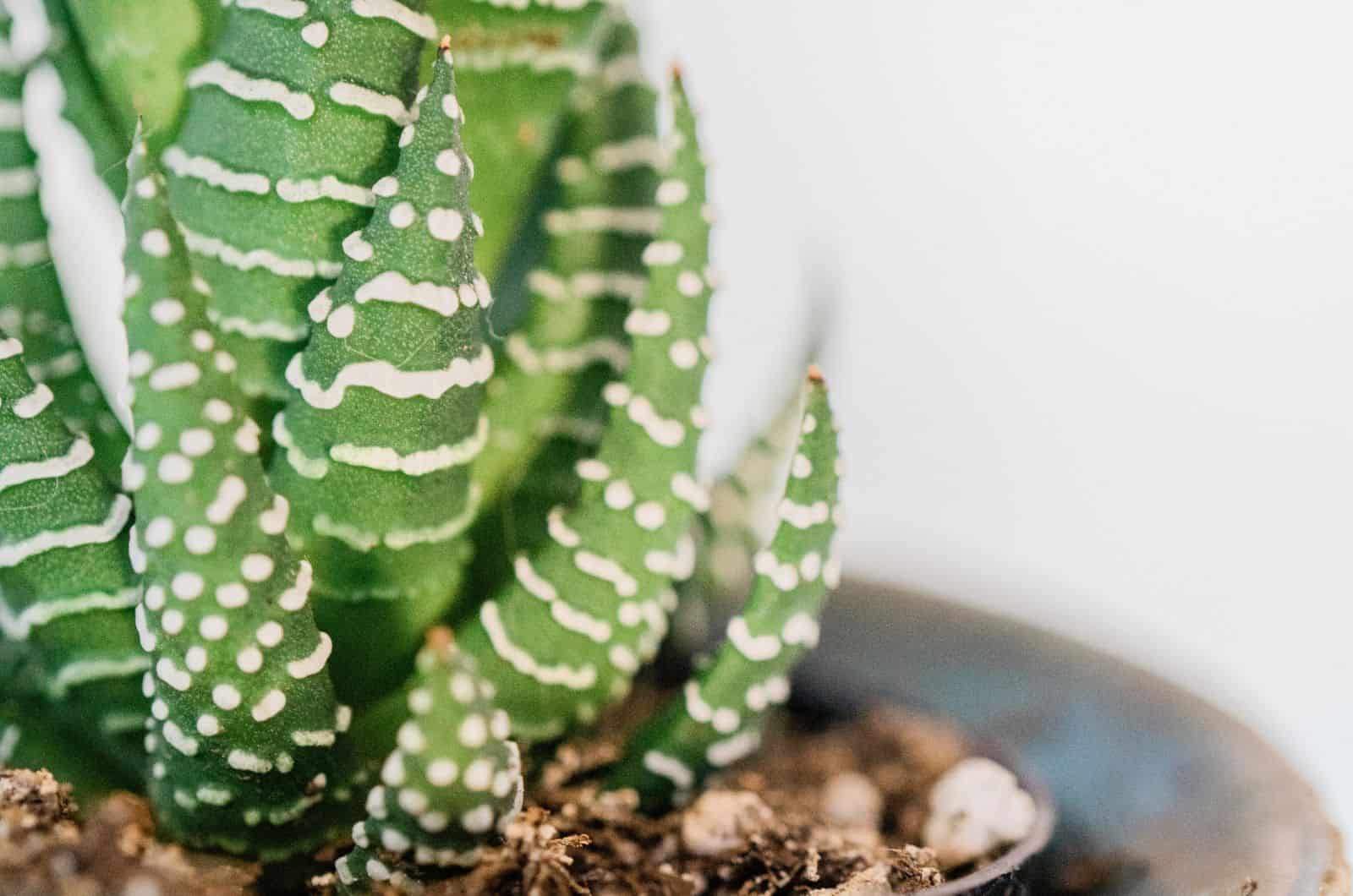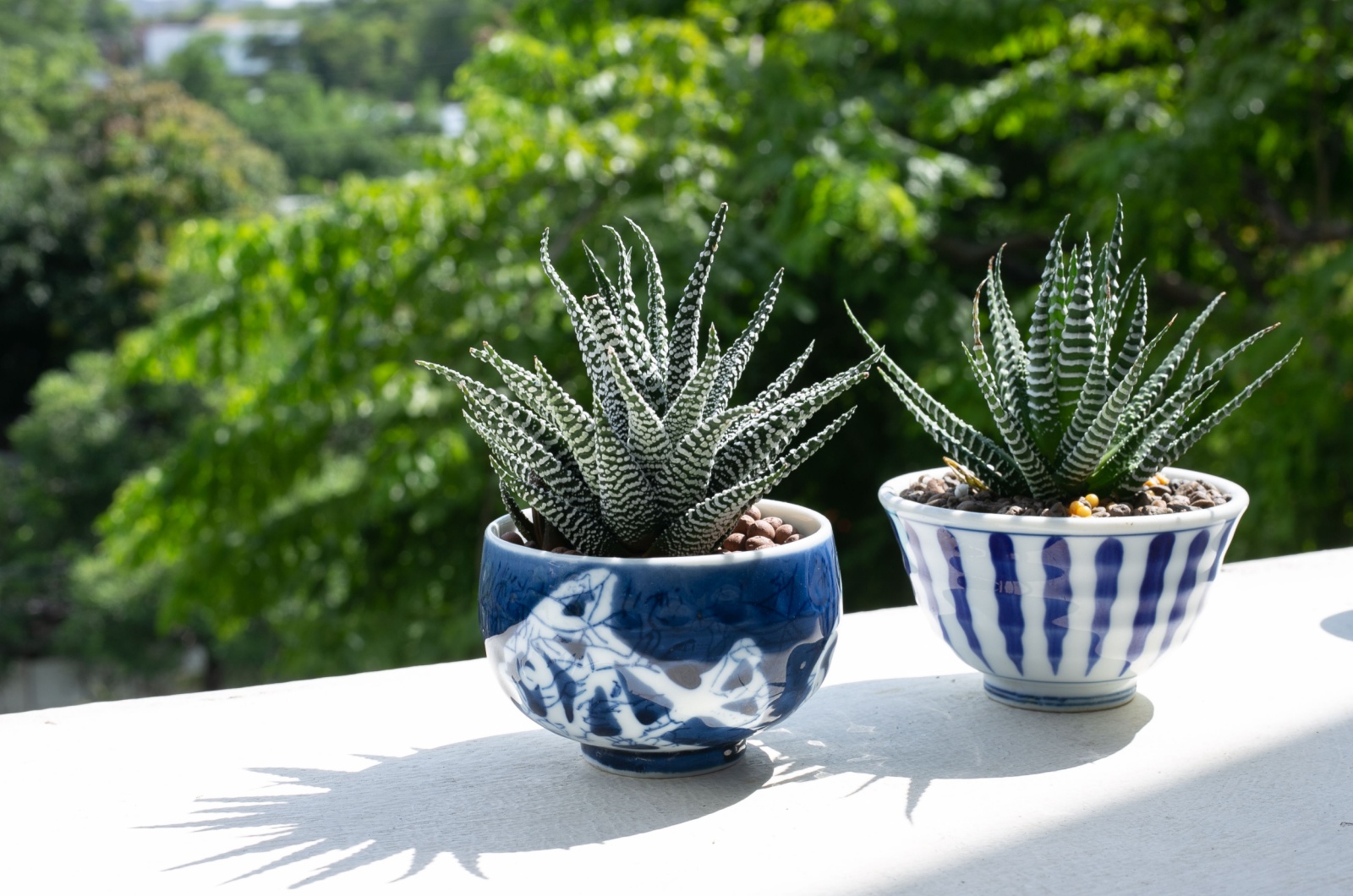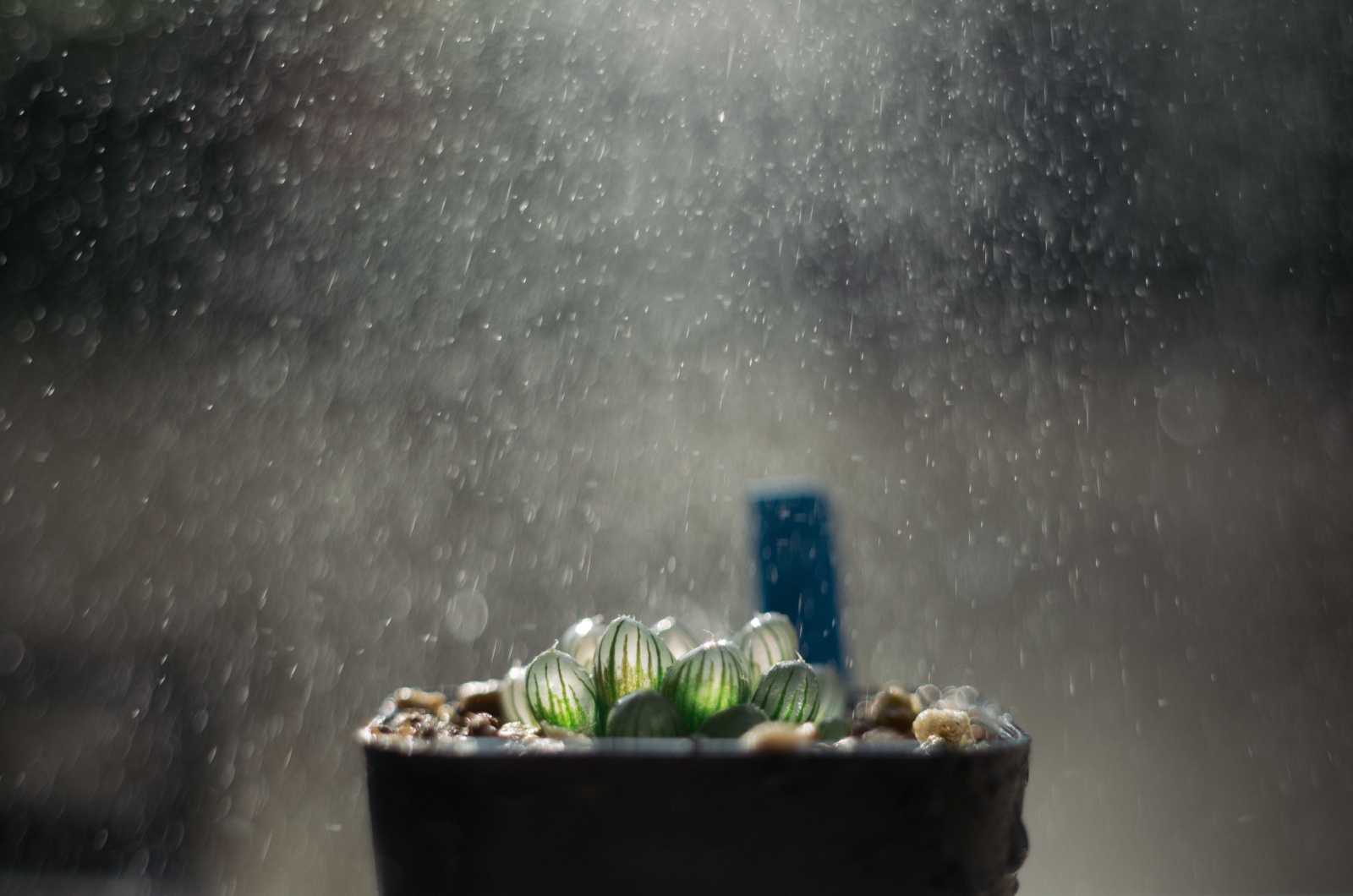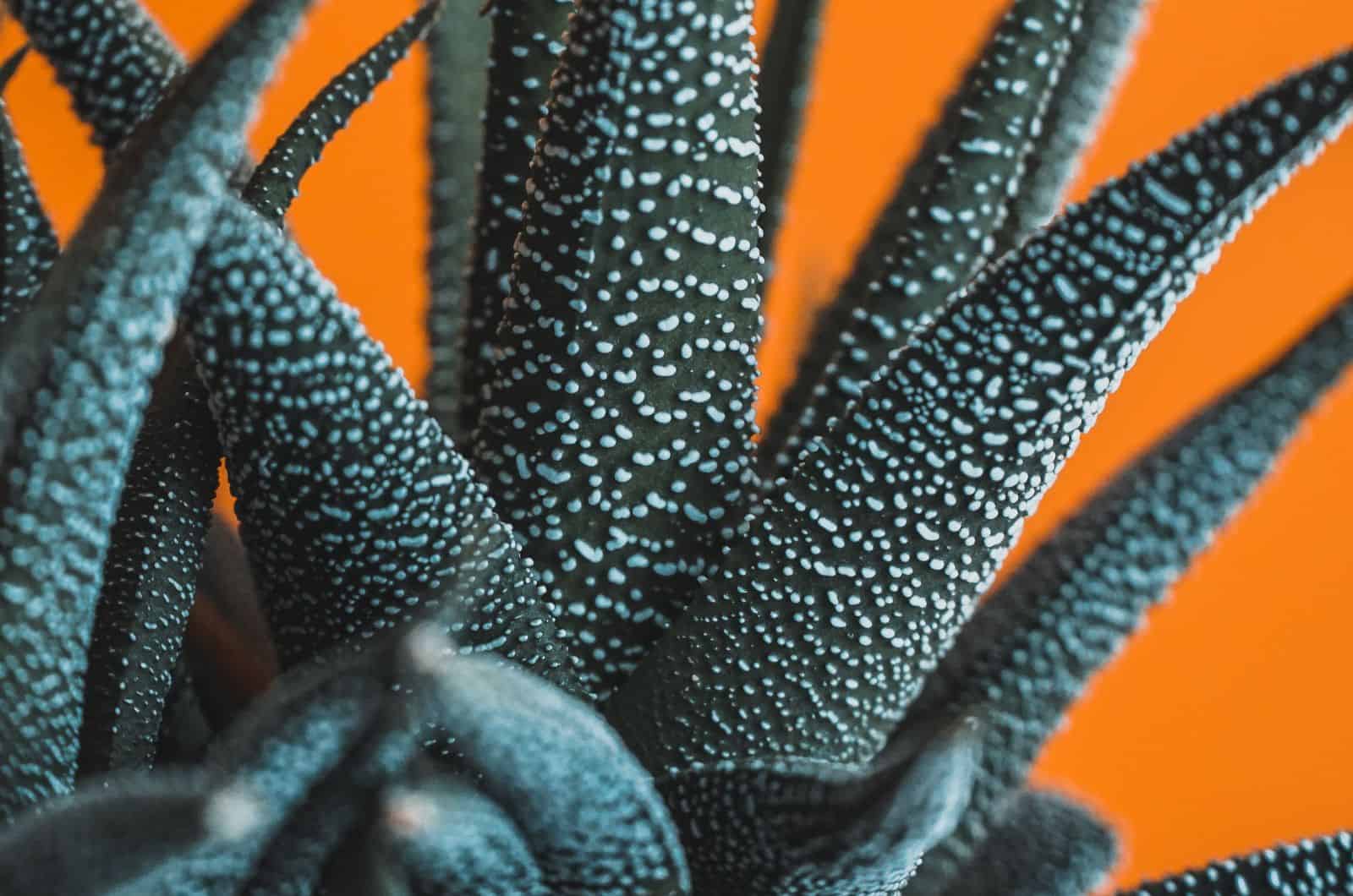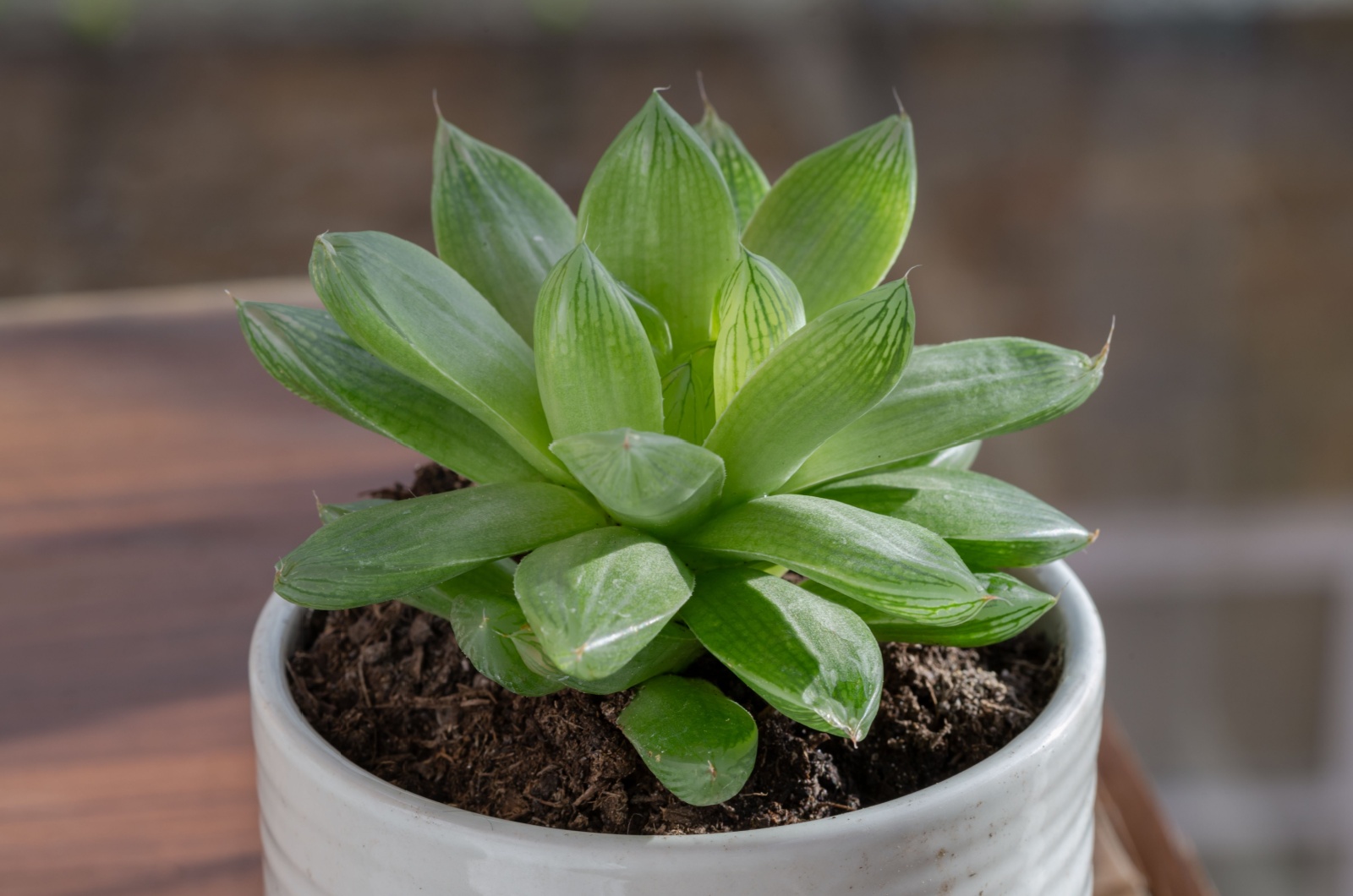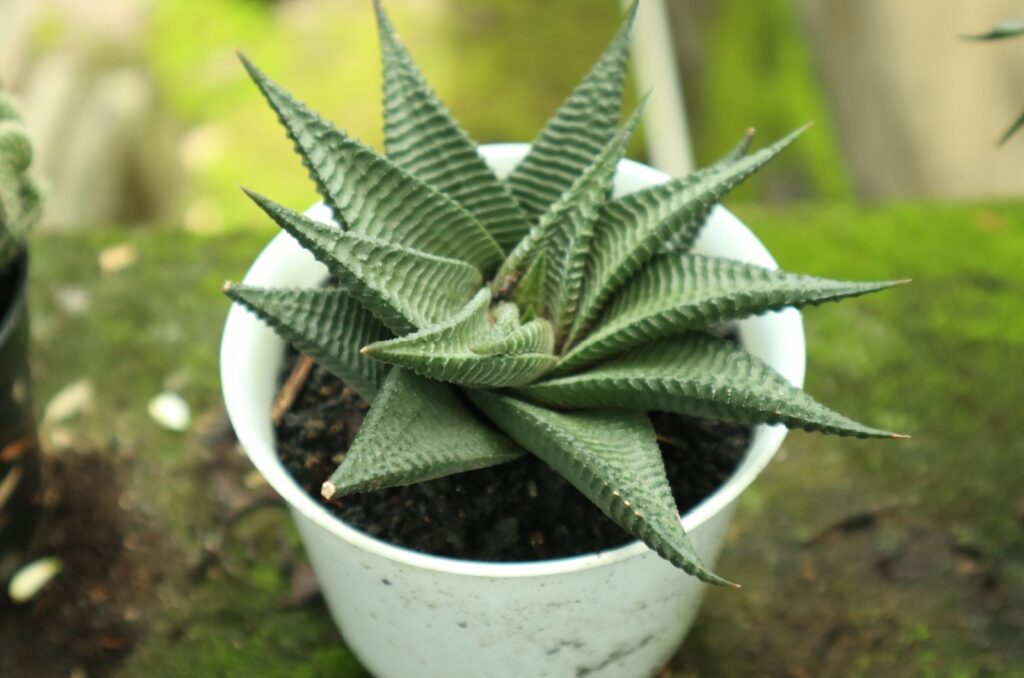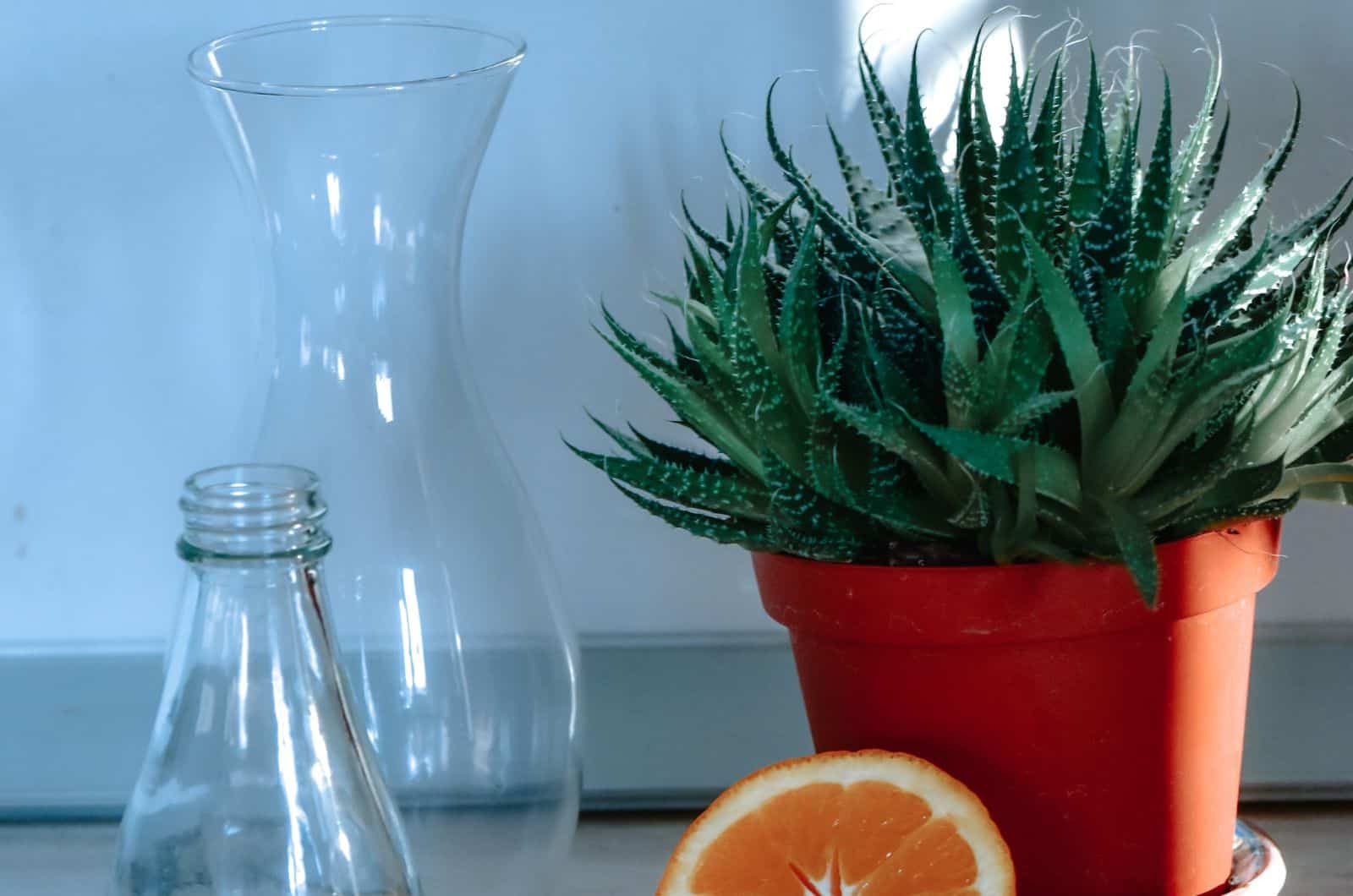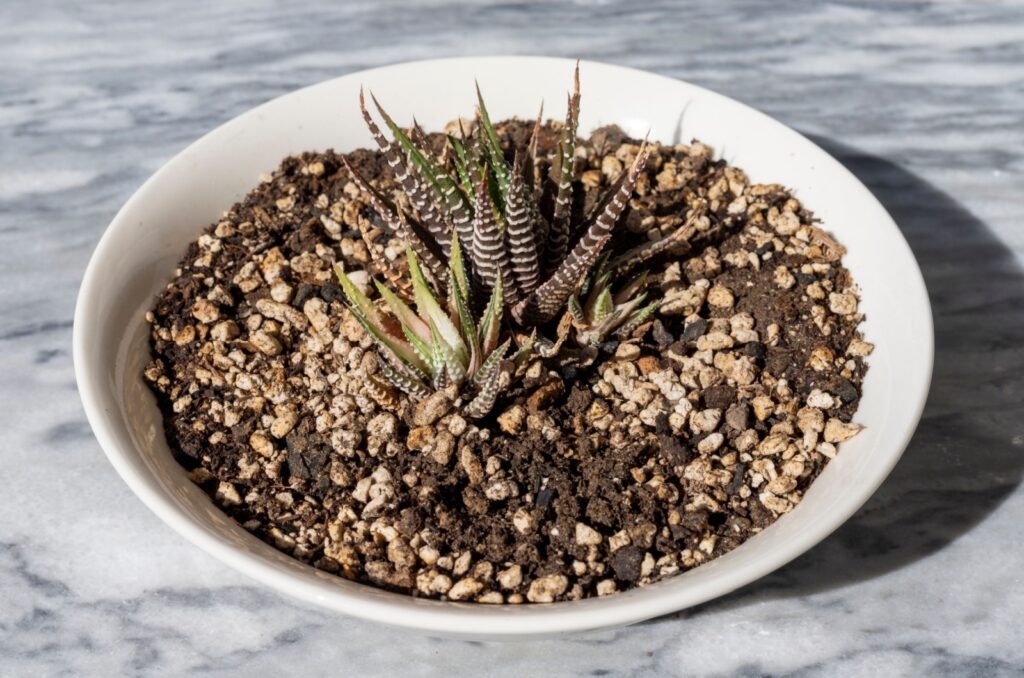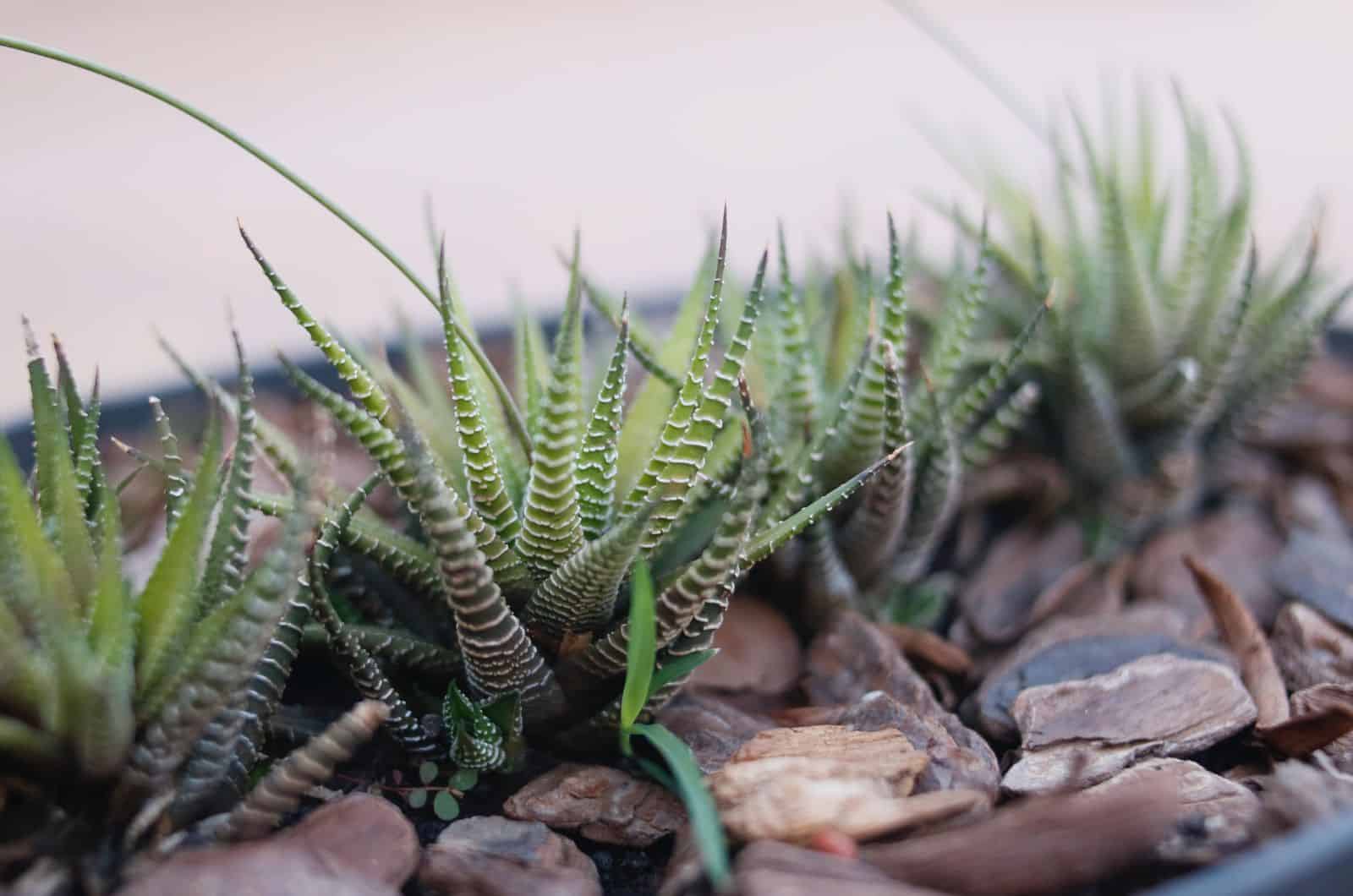Succulent plants are amazing houseplants with so much to offer, and they require very little care. You can choose one with pointy or blunt leaves, that’s colorful or green, tall or short, and so on, and on, and on!
But there is one species whose rosettes and fleshy leaves can bring a whole new vibe into your home: haworthia succulents.
There are a wide range of haworthia types, but today we bring you the fifteen most popular varieties you can grow in your home.
Before we examine some different haworthia plants, let’s look into their basic info:
15 Haworthia Types
Most of the species of haworthia you’ll find below are native to Cape Province in South Africa, but when we look for the perfect indoor plant to complement our decor, its origin comes second to its looks.
Therefore, we’ll briefly describe the different varieties so that you can choose the best one for your home!
1. Haworthia Cooperi
Haworthia cooperi is a stemless variety that looks like a cluster of grapes. The blue-green leaves are smooth, rounded, and almost translucent.
This type usually gets around 3-5 inches tall and no more than 4 inches wide.
2. Haworthia Truncata
H. truncata is also known as the horse’s teeth because of its appearance. It is another stemless haworthia with truncated, rectangular foliage.
But unlike H. cooperi, truncata has warts on its gray-green surface. But these don’t taint the plant’s good looks; they just add more charm.
Finally, this type is relatively compact and grows only 3-4 inches tall.
3. Haworthia Fasciata
H. fasciata, also known as the zebra plant or zebra haworthia, is one of the most famous haworthias. However, it is now classified as Haworthiopsis, but we’ll talk more about the differences between haworthia and haworthiopsis later.
The dark green leaves are pointy, while the bottom side is lined with white horizontal stripes. It is one of the taller haworthias as it can get 5-8 inches tall.
If you’ve ever wanted to know whether succulents like humidity, you don’t have to wonder any longer; this variety can withstand somewhat higher humidity levels, so you can show it off in a modern, glass terrarium.
4. Haworthia Coarctata
Another taller haworthia type is H. coarctata, but its 8 inches of height still make it suitable for small places in your home.
This variety has also been reclassified into the genus Haworthiopsis.
Unlike the previous types, this one actually has a stem decorated with fleshy, dark green foliage. However, if you grow this haworthia on a sunny windowsill, its green color would turn purplish-red.
Its stem can grow up to 8 inches long!
5. Haworthia Retusa
This variety is usually around 4 inches tall, but its racemes (inflorescence) can get as big as 20 inches.
The raceme soars above the thick, green, triangular leaves and exhibits its white flowers in full glory in early summer.
6. Haworthia Attenuata
If you’re looking for more plants with pointy leaves to add to your collection, you don’t have to look further than the H. attenuata.
This variety also belongs to the genus Haworthiopsis now and is another type of zebra plant. However, you can easily distinguish it from H. fasciata.
Haworthia attenuata has black and white horizontal stripes and extends the inflorescence about 16 inches into the air.
The plant itself is around 3 inches tall and 6 inches wide.
7. Haworthia Cymbiformis
If you only have room for a small plant to decorate your coffee table, you won’t go wrong with an H. cymbiformis.
This variety is usually around 3 inches tall, but it is its leaves that are the true sensation.
They are fleshy and arched, so they resemble tiny boats. The bright green color is mesmerizing, and the transparent lines at the leaf tips only add to the overall allure.
8. Haworthia Bolusii
There are different bolusii varieties, and some can be thorny, others almost appear hairy, some look translucent, some are darker, etc.
However, all of them are easy to grow, and can get to around 4 inches tall with 8-12 inch long inflorescence that bears white flowers streaked with green veins.
9. Haworthia Reinwardtii
This small succulent variety has columnar and elongated rosettes of fleshy, white-dotted foliage, while its inflorescence bears pink-white flowers in spring.
The plant itself isn’t that tall, and it usually reaches around 8 inches.
It’s been moved to the genus Haworthiopsis together with some other varieties.
10. Haworthia Limifolia var. Striata
This small plant is another variety that’s been reclassified into the Haworthiopsis genus.
The triangular leaves are streaked with white horizontal ridges that beautifully contrast the deep green background.
It is a short succulent plant that only grows up to 4 inches, but its racemes can reach up to 14 inches and exhibit cute, white flowers adorned with green veins.
11. Haworthia Arachnoidea
This variety looks like a starry ball woven by spiders. The leaf color can be bright to dark green, and the tips are usually tiny needles.
H. arachnoidea doesn’t get taller than 7 inches, which makes it ideal for small spaces.
12. Haworthia Angustifolia
Along with the H. fasciata, Haworthia angustifolia is one of the most popular varieties of this species.
It typically has wider foliage, but there are types with narrow leaves. They can be bright or dark green and even brown. They reach their full potential if you grow them in bright light conditions.
They are around 2-3 inches tall with a smooth leaf surface.
13. Haworthia Bayeri
The triangular leaves of this variety are extraordinary. They are dark green and somewhat semi-translucent and streaked with numerous veins.
It can get around 3-5 inches tall, but that only makes it more appealing to haworthia growers.
14. Haworthia Emelyae
H. emelyae resembles H. bayeri due to its thick, triangular foliage and similar height (3-5 inches). Both varieties have leaves turned in such a manner so as to provide a flat, level surface on the ground.
However, the Haworthia emelyae has a unique, convex leaf shape, and its often streaked and spotted with pinkish markings.
15. Haworthia Koelmaniorum
This variety looks like a dark red starfish whose surface is covered in warts. It might not seem attractive, but once you set your eyes on this beauty, you won’t be able to look away!
It usually reaches 4 inches in height and is super easy to care for, so it’s not surprising that many gardeners choose precisely this variety.
Finally, the Haworthia koelmaniorum is another variety that’s been reclassified and moved to the genus Haworthiopsis.
Haworthia vs Haworthiopsis
We mentioned how some haworthia types are now actually reclassified as haworthiopsis, and it’s time to explain why that happened.
The genus Haworthia celebrates Adrian H. Haworth, a British botanist and an entomologist known for his work on moths, butterflies, and succulents.
The suffix -ópsis signifies that these plants are “like haworthia”. Botanists moved them to another genus due to their foliage, which has a thicker outer cover.
But both genera belong to the aloe family (Aloaceae)
Care Guide For Haworthia Succulents
The first thing we learn when we get new plants is how to care for them. The good news is that haworthia plants are succulents, so they don’t require much; just keep them in bright light, plant them in well-drained soil, and water them once the potting medium dries out.
Of course, there are other things you need to consider if you want to grow strong and healthy plants, and we’ll discuss them in the following paragraphs.
Light Requirements
Haworthias are relatively resistant plants that can thrive in partial shade and direct sunlight. However, they won’t reach their full potential if you don’t grow them in bright light conditions.
If they’ve been exposed to low-light levels for a long time, you should move them to a brighter spot gradually so that the sun doesn’t burn its beautiful foliage.
Also, there’s nothing wrong with using grow lights for plants; just make sure you keep your green buddy at least 1 foot away from them so that they don’t burn their attractive foliage.
Can Haworthia Tolerate Full Sun?
One of the things we’ve been frequently asked is whether haworthias can tolerate direct sun. Well, yes, to some extent.
Direct morning sunlight is ideal for these plants, but if you expose them to afternoon light during the hot summer months, they can sustain sunburns and obtain an unsightly brownish hue.
Therefore, make sure not to keep them on west-facing windowsills as these places are too hot for your delicate haworthia.
However, places near east or south-facing windows are perfect!
Water And Humidity
The first thing you need to pay attention to when irrigating your plants is the type of water you use. For instance, rainwater is suitable for plants as it doesn’t contain chlorine, which can build up and inhibit their ability to absorb moisture and minerals.
Another important thing is to avoid overwatering at all costs, as it can quickly lead to root rot and kill your plant if you don’t deal with it.
Therefore, only irrigate your haworthia plant once the potting medium has been dry for a couple of days.
These plants are fairly drought-resistant, so they won’t suffer from being underwatered like they would from overwatering.
Generally speaking, you shouldn’t water them more than twice a month, although you should irrigate them more frequently in warmer regions and summer months.
Humidity
The good news is that you don’t need a high-humidity environment to grow a healthy haworthia plant. In fact, too much air moisture can be detrimental and stress your plant.
This species prefers relative humidity between 25-35%, but it can tolerate higher levels, which makes it an ideal plant for a glass terrarium.
Temperature
Haworthias aren’t known for their cold hardiness, but they can still tolerate temperatures as low as 40 degrees Fahrenheit if you reduce watering and avoid keeping them in wet substrates.
However, they prefer to be kept at temperatures between 75-90 degrees Fahrenheit. They love warmth, so they’ll easily survive temperatures of around 100 degrees Fahrenheit as long as they have enough moisture and good air circulation.
Finally, don’t keep these perennials near heaters and AC vents as these places experience sudden temperature swings, which can stress your haworthia.
Potting Soil And Fertilizer
When talking about the potting medium for haworthia plants, one thing you should bear in mind is that the substrate needs to be sandy or gravelly with excellent drainage to avoid water pooling.
Therefore, if you haven’t bought a succulent soil mix, you can always add perlite, pumice, and gravel to some other fast-draining medium to make it perfect for these succulents.
Fertilizer
Haworthias are slow-growing plants, so they don’t require too much fertilizer. However, you can feed them with diluted succulent plant food during their growing season.
You can also try using banana peel tea for plants as it’s rich in potassium. Still, you should combine it with some other fertilizer that’s rich in nitrogen because haworthias require a fair amount of that nutrient.
Finally, whether you use synthetic or organic fertilizers, you should always water your plants before or after feeding them to avoid fertilizer burn.
Repotting
Haworthia plants aren’t speedy growers, so you won’t have to repot them too frequently. However, you should still move it to a new pot or at least fresh soil every 2-3 years.
Replacing the growing medium will replenish the minerals and prevent salt build-up, which can happen if you fertilize your plants.
Also, you don’t always have to choose a larger planter. Too large containers can lead to water-pooling and root rot.
Furthermore, the best time to repot your haworthia is in spring or early summer, as that’s when this plant grows and develops and is more likely to acclimate to the new soil.
When choosing a pot, ensure it has drainage holes because this plant is sensitive to water clogging.
Water your plants thoroughly a couple of days before repotting to help them adjust to the new soil better. Untangle the roots carefully, plant the haworthia in a new pot, and irrigate it!
Here are some more haworthia repotting tips:
Propagation
There are many different methods of plant propagation, but the good news is that the haworthia can be propagated by the easiest ones, or rather by transplanting offsets and leaf cuttings.
We’ll discuss both methods in the following sections.
Propagation From Offsets
When you repot your haworthia, you can also propagate it if you notice offsets. Simply take sharp, sterilized scissors or a knife, and cut the offset as close to the parent plant as you can.
Don’t forget to take as many roots as possible, as they’re essential for plant growth.
Plant the offset into a new pot, expose it to bright light, and irrigate it once the medium dries out (just like you would water the established plant).
Propagation From Leaf Cuttings
The best time for this type of propagation is at the beginning of the plant’s growing season. Use a sharp, sterilized knife to take a healthy cutting.
Add some rooting hormone to the leaf cutting and let the wound heal a bit before potting (this might take a couple of days).
Plant the leaf cutting into a fresh succulent soil mix, water it, and place it in a bright spot (avoid afternoon direct sunlight as it can hurt your delicate plant).
Ensure that the soil is slightly moist, but never completely wet, as it can lead to root rot.
In a couple of weeks (or more), the cutting should develop a root system. You can check this by gently tugging it; if you notice any resistance, the roots have developed.
Here’s a video that shows how you can propagate zebra haworthia from leaf cuttings:
Common Problem With Types Of Haworthia Plants
This plant is, unfortunately, not resistant to pests and diseases, so you’ll definitely deal with these issues at some point.
Of course, excellent care minimizes the risks of infestations and infections, so make sure to meet its requirements.
But should the worst happen, it’s always better to be prepared. That’s why we brought a couple of tips for dealing with these issues.
Pests
The most common bugs that can infest your haworthia are mealybugs, spider mites, aphids, and scales. As soon as you notice them parading all over your green friend, separate the afflicted plant from the rest to stop the infestation from spreading.
You can use pesticides to remove them, horticultural oils, introduce natural predators such as ladybugs, or even pick them off one by one if the infestation is not too large.
Diseases
One of the most common diseases that afflicts haworthia plants is root rot. It appears as a result of excess soil moisture, so you should make sure to plant your haworthia into a pot with drainage holes, well-drained soil, and to water it only when the medium dries out.
Of course, the unpredictable can always occur, and if you suspect something’s wrong with your plant, always check its roots.
If they have turned dark (brown or black) and are soft and squishy, your plant is infected.
There is a way to cure it if not all roots are affected. Take some sharp and sterilized pruners and remove all diseased parts.
Then, treat the rest of the roots with a fungicide as a precaution and to destroy any viable fungi spores.
Finally, plant your haworthia into fresh soil and a new pot (or you can thoroughly clean the old one), water it, and place it in indirect light.
Discolored And Disfigured Leaves
Sometimes, the leaves of your plant can curl, which may indicate that your plant needs more moisture. However, always check the soil before watering it, as curly foliage may also mean that your plant has received too much light.
Excess sunlight can also lead to leaf discoloration, and your beautiful zebra plant will turn brown.
Finally, yellow foliage may indicate a number of things. For instance, it can mean that your plant is getting too much or not enough light. Low-light conditions result in a loss of chlorophyll, while excess light burns the foliage.
Yellow haworthia foliage may also mean that this plant has been overwatered. With overwatering, it’s usually the bottom leaves that are affected.
But if it’s the top foliage that’s turning yellow, it might signify that your plant is suffering from nutrient deficiency, so you should repot it into fresh soil or give it some plant food.
FAQ
We discussed some popular haworthia types and their basic requirements, but there are still some questions and fun facts you asked us about.
Therefore, we decided to answer a couple of your frequent questions below!
How do I identify my haworthia?
The most prominent feature that can help you identify haworthias are the leaves, so look for their shape (whether they are pointy, triangular, rectangular, or round), their color, and whether they have spines, warts, hair-like structures, etc.
Sometimes, even the flowers can help you identify a certain haworthia variety (for instance, H. reinwardtii produces pinkish flowers).
What is the name of the smallest haworthia?
Haworthia parksiana is known as the smallest haworthia type; it can only get about an inch tall.
Final Thoughts
This article included everything you need to know about haworthia types. We examined some of the most popular ones so that you can choose which will decorate your home best.
We also discussed the differences between the Haworthia and Haworthiopsis genera so that there isn’t any confusion, and we included a detailed care guide for all haworthia succulents.
Finally, we discussed some common issues that may befall your green friend just so you know how to deal with them if it ever happens.
Hopefully, you’ll be able to choose between all these breathtaking types!
Until next time!
Like this post? Share or pin it for later!



